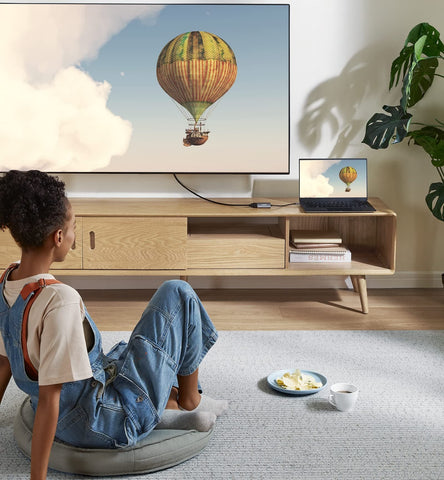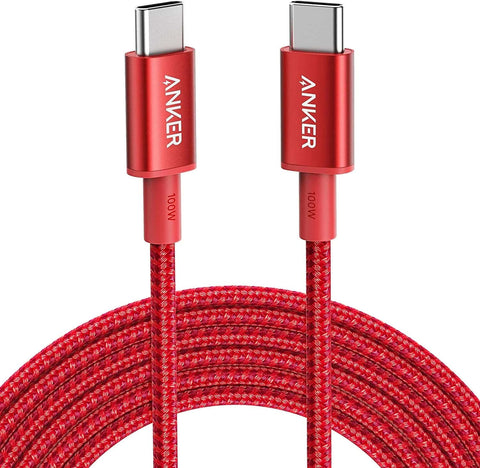
Untapped Potential: Can a USB-C Port Be Used for Display
Navigating the world of connectivity and display options can be a crucial aspect of setting up your tech suite. A noteworthy query amongst users revolves around the potential of USB-C ports for display purposes. Clearing doubts, 'Can a USB-C port be used for display?' is the spotlighted subject for this discussion. This article contains detailed information on the advantages of using a USB-C accessory to connect your visual display, step-by-step instructions for establishing the connection, and an in-depth analysis of the factors that affect the performance of USB-C displays.

What are the advantages of having a USB-C accessory for your display?
Single Cable Solution: USB-C is a versatile connector that can handle multiple protocols, enabling the transfer of video, audio, data, and power simultaneously. This means connecting your display using a single cable reduces clutter and simplifies the setup.
High-Speed Data Transfer: USB-C offers faster data transfer rates than previous USB generations, with speeds of up to 10 Gbps (USB 3.1 Gen 2) or even 40 Gbps with Thunderbolt 3/4. This enables faster file transfers and reduced latency, improving overall usage experience.
4K and 8K Video Support: USB-C is capable of transmitting 4K and 8K video signals between your device and display, providing high-quality, crisp visuals for playback or content creation. This makes it ideal for video gaming, video editing, and other visually intensive applications.
Universal Compatibility: As USB-C becomes the standard connector for most devices, having a USB-C accessory for your display ensures compatibility with a wide range of devices, including laptops, smartphones, and phablets/tablets. This future-proofs your display setup to prevent obsolescence.
Power Delivery: USB-C can deliver power to connected devices using the Power Delivery (PD) standard, making it an effective solution for powering and charging portable devices. This eliminates the need for multiple chargers & power adapters, streamlining your workstation.
Reversibility: USB-C connectors are reversible, enabling easy connection without worrying about the orientation of the cable. This makes plugging and unplugging devices quick and hassle-free.
Daisy Chaining: Some USB-C accessories support daisy-chaining, allowing you to connect multiple devices together with a single cable. This can further simplify your setup and keep your workspace organized.
How to connect USB-C to your display?
Here are three of the most convenient ways to establish a display connection:
Through Cables
One of the direct and simplest ways to connect your USB-C to a display is to use USB-C cables. Here's how you can do it:
Check the Compatibility: Can all USB-C ports be used for display? Different displays have different ports. Some have HDMI, some have DisplayPort, and some have USB-C ports. Make sure you have a USB-C cable that's compatible with your display's port.
Connect the Cable: Connect the USB-C end of the cable to your device and the other end to your display.
Change Settings (if required): The device automatically detects the connection. If not, go to your device's display settings and select the correct display output.
If you're looking for the right cable, experience remarkable performance with Anker's USB-C cables, designed for impeccable charging efficiency, high-speed data sync, and superior video output. We pride ourselves on their durability, ensuring a seamless connection for all your USB-C devices, whether you're at home, in the office, or on the move. And no matter your length preference, we've got a solution tailored just for you. Trust in Anker for unparalleled cable performance.

Through Docking Stations
If you have multiple peripherals and displays to connect, a docking station can be a great solution.
Choose Your Docking Station: Purchase a USB-C docking station that supports display output. Some docking stations can power multiple displays, so be sure to choose based on your needs.
Setup the Docking Station: Connect the docking station to a power supply if necessary. Then, connect your hardware to the various ports on the docking station.
Connect to Your Device: Plug the USB-C end of the docking station into your device.
Seeking the ideal companion for your docking station requirements? Look no further! At Anker, we've crafted the Anker 778 Thunderbolt Docking Station (12-in-1, Thunderbolt 4) to provide you with extensive connectivity choices, all driven by a potent 100W Thunderbolt 4 port. Experience stunning visuals with support for 8K displays and take advantage of a whopping 40 Gbps bandwidth. With our hub, you'll enjoy efficient charging up to 30W through the USB-C ports, ensuring your laptop remains powered and ready for those crucial multi-display setups. Join us in redefining connectivity.

Through Adapters
An adapter can also be used to connect your USB-C device to a display. This approach generally offers the most flexibility, supporting a range of connections such as HDMI, VGA, or DVI. Here's how to proceed:
Find a Suitable Adapter: As with a cable or docking station, ensure the adapter's output (HDMI, VGA, etc.) is compatible with your display.
Connect the Adapter: Connect the USB-C end of the adapter into your device, and the other end to the cable of your display.
Change Settings (if required): On your device, select the correct display output.
Finding your perfect companion? The Anker 518 USB-C Adapter features superior 8K@60Hz and 4K@144Hz resolution support, delivering crystal-clear video while mirroring or extending your screen. Designed for ease, this plug-and-play marvel effortlessly converts your laptop's USB-C port to HDMI, eliminating any need for complex installations. Want to binge on your favorite HDCP-encrypted movies or shows? We've got you covered. With universal compatibility embracing DisplayPort Alt Mode, our adapter seamlessly connects with a wide range of TVs, monitors, and projectors. Trust in Anker for a connection that truly shines.

Factors Affecting USB-C Display Performance
Several factors can affect the performance when connecting a USB-C device to a display:
Type of Connection: Can I use USB-C for monitor? The type of connection can significantly impact quality. For example, an HDMI cable generally supports higher resolutions and refresh rates than a VGA cable.
Quality of the Cable/Adapter/Docking Station: A low-quality or damaged cable, adapter, or docking station can hinder the connection, causing performance issues such as flickering, color distortion, or input lag.
Device Capability: Different devices support different display specifications. Make sure your device supports the display's resolution, refresh rate, and other features.
Display's Own Capability: The display's inherent capability influences its performance. A display with a high refresh rate and resolution will perform better compared to a less proficient one, given the device and connection used can support these features.
USB-C Port Version: The USB-C port version on your device can affect performance. For instance, a Thunderbolt 3 port can support up to two 4K displays at 60Hz, while not all USB-C ports have these capabilities.
Conclusion
So, after diving deep into the world of USB-C and displays, the big takeaway is this: "can a USB-C port be used for display?" Absolutely, and it's a game-changer! From versatile connection options with cables, docking stations, and adapters to the sheer convenience it offers, USB-C is making our screen-time smoother and more integrated. Just remember to check those specs and ensure you've got the right gear. As tech keeps advancing, the line between our devices and how we connect them continues to blur, and USB-C is right at the forefront of that evolution. Cheers to clearer, simpler, and more connected viewing!
FAQ
Here are some commonly asked questions regarding "Can a USB-C port be used for display?".
Do you need a specific USB-C for display?
Yes, to transmit video signals and connect to a display, you need a specific USB-C cable that supports DisplayPort Alternate Mode (Alt Mode). While it might be tempting to think all USB-C cables can connect to a monitor, that's not the case. Always review the cable's specifications to ensure it's up for the task before buying.
Is a DisplayPort the same as USB-C?
Does all USB-C support DisplayPort? No, DisplayPort and USB-C are not the same. DisplayPort is a dedicated video and audio interface, while USB-C is a versatile connector standard with many functions. However, USB-C can support DisplayPort signals via Alternate Mode, allowing video and audio transmission similar to a DisplayPort connection.
Can I connect my laptop or smartphone to an external monitor or TV using a USB-C cable?
Can I use USB-C for monitor? Yes, you can connect compatible laptops or smartphones to an external monitor and/or TV using a USB-C cable that supports DisplayPort Alternate Mode. Ensure your devices and cable support this functionality for a seamless connection.















